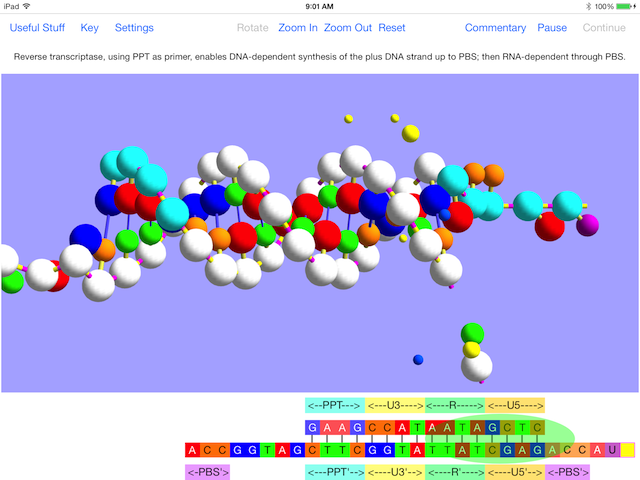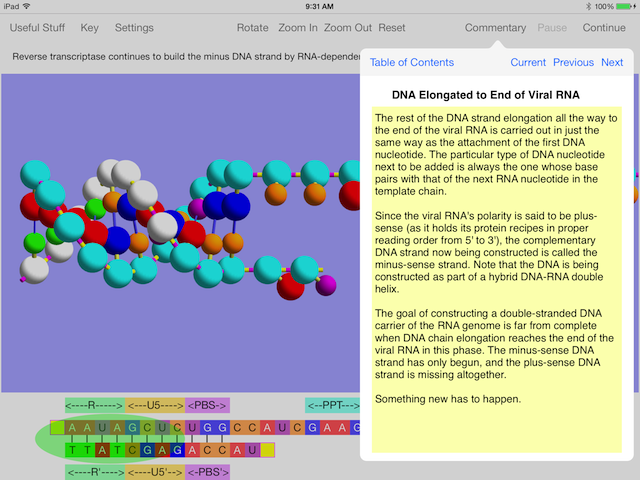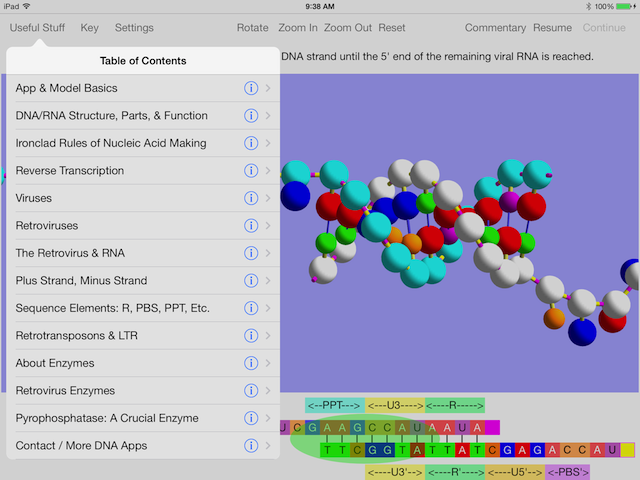OnScreen Retrovirus, my latest iPad app has been on the App Store for a couple of months now, so it’s high time I said something about it. Since the new iPad & iPhone operating system iOS 7 will be available to the general public September 18 and Apple is now accepting submissions of new apps and app updates written for it, I can show what the app will look like with the new interface. Let that be a justification for the antabuse delay.

The AIDS virus is the most notorious of the retroviruses, which is why I put it in the headline, but there are many more, including some nasty ones that cause cancer. I didn’t know much about retroviruses, or any viruses for that matter, until a year or so ago, when I decided I really should learn more. The detailed knowledge of how DNA works, which I gained during the course of developing the other DNA apps (OnScreen DNA Model, OnScreen Gene Transcription, and OnScreen DNA Replication), had heightened my curiosity about viruses, while providing me with the background to make the road to understanding easier.
Viruses are very strange creatures—or should I say objects? To quote from the first paragraph of my entry on Viruses in the app (from Useful Stuff popover view in one of the images below):
Are viruses alive? Look up virus metabolism, and you’ll come to a blank page. So viruses aren’t alive in the usual sense that living cells and multicellular creatures are. Yet viruses consist of proteins and genetic material, which are crucial constituents of living creatures, and, when in the proper environment (in their “host” cell), viruses can reproduce in their own unique way. So it’s really a matter of taste whether to call them alive or not.
Just as “real” organisms do, viruses make use of nucleic acids to store instructions for making the proteins vital to their survival. These proteins are few in number since the virus doesn’t have to make a living, but only hole up safely until it can enter a cell to reproduce, making use of a cell’s protein-construction apparatus. The full set of nucleotide sequences of the virus’s nucleic acid (which may be DNA or RNA, single-stranded or double-stranded, depending on the type of virus it is) is its genome.
The genome of a retrovirus is contained in a single strand of RNA. The way in which a retrovirus uses a few enzymes (proteins) it contains to construct a double-helical-strand of DNA, which also contains its genome, the virus’s RNA serving as a template, is fascinating. Mind-blowing, I think, as it depends on there being certain sequences of nucleotides at just the right place and in just the right order to enable nucleic acid strands involved in DNA synthesis to separate and then join again at another place in order to continue the process. Anyway, the simulations of OnScreen Retrovirus show how this happens in a detailed way that I think makes it very clear. And clearly mind-blowing!

OnScreen Retrovirus doesn’t show either the full virus entering the cell or the completed DNA being inserted into the host cell’s DNA. There are some good animations you can find online to see, at least in a sketchy way, those events. What I have not found online is any detailed simulation of the genome replication, and that is what OnScreen Retrovirus takes care of, making use of the same three-dimensional ball-and-stick model of nucleic acids featured in the other OnScreen Science iPad simulations.
The app’s Useful Stuff items and the Commentary for each step of copying the retrovirus’s RNA genome to DNA explain what you see in the simulations, necessarily introducing several key concepts, of which the screen shots should give an idea.

It’s a accutane bit disconcerting to think of it (like the knowledge that our bodies contain more bacteria than human cells), but our DNA, for all its stability in the context of ordinary cell metabolism, contains many short segments called transposons that either move from place to place in their chromosome or make copies of themselves to be inserted at another location. Transposons accomplish their transpositions by utilizing the cell’s machinery to produce the enzymes needed to accomplish the task. In particular, those called retrotransposons have their DNA transcribed to strands of messenger RNA, some of which are used to synthesize enzymes, which act on other strands of the RNA to make double-stranded DNA to be inserted elsewhere in the cell’s DNA. Exactly the way a retrovirus does. So the simulation of OnScreen Retrovirus provides a simulation of a retrotransposon’s DNA synthesis as a bonus.
About iOS 7, I can say that for the OnScreen Science DNA apps, the changes are basically cosmetic and, I think, all for the good. The old tool bars and buttons of previous versions of iOS seem awfully dark and gloomy compared to the new ones. The new “buttons” are really more like links on a web site, just colored text on a light background, but people are used to links, and I think that change will go over well.
I hope to have all four of the OnScreen Science iPad apps that deal with DNA and RNA ready for sale on the App Store before the public release of iOS 7. The new updates will continue to support iOS 6, though not iOS 5, which means they are saying goodbye to the original iPad. Anyone wanting to run these apps on an original iPad had better hurry to get them before the updates go through. The updated apps will run on iOS 6 and just switch over automatically to their iOS 7 versions once they are running on a device with iOS 7 installed.
Update: before I could post this, I got word that version 2.5 of OnScreen DNA Model was going live on the App Store. So it is now too late to get it for the original iPad. I think Apple has app updates for iOS 7 on the fast track for approval, since I submitted only yesterday. So, you really must hurry if you have an original iPad and want to run these apps.
FLASH! (added 9/21/13) Although Apple has not announced it yet, it is now possible (and hopefully a permanent new feature) to download earlier versions of apps that have been left behind when updates raised the minimum iOS requirement. That means it is still possible, for instance, for people using the original iPad, which can’t run any iOS version greater than 5.1, to purchase OnScreen DNA Model even though the most recent version 2.5 requires iOS 6 or greater. Version 2.4 of the app, which is virtually identical, can still be downloaded. Just proceed as if you hadn’t noticed the iOS requirement. The App Store software will detect that your device can’t support the latest version of the app and will ask if you want to get a previous one your device can run instead. If you say yes, the older version will download and install. And all is as if you had purchased the app when that version was the latest. You are https://drbarletta.com/celexa-citalopram/ entitled to free updates on other devices in the future. I verified all this myself with actual downloads, but we can’t know whether it’s a permanent feature or just a test of a possible one until Apple says something about it. So far, they have only acknowledged it for updates on older systems.
Tags: DNA Model, double helix, iPad app, iPad developing, OnScreen DNA, science simulations



 OnScreen
OnScreen
 OnScreen
OnScreen OnScreen
OnScreen